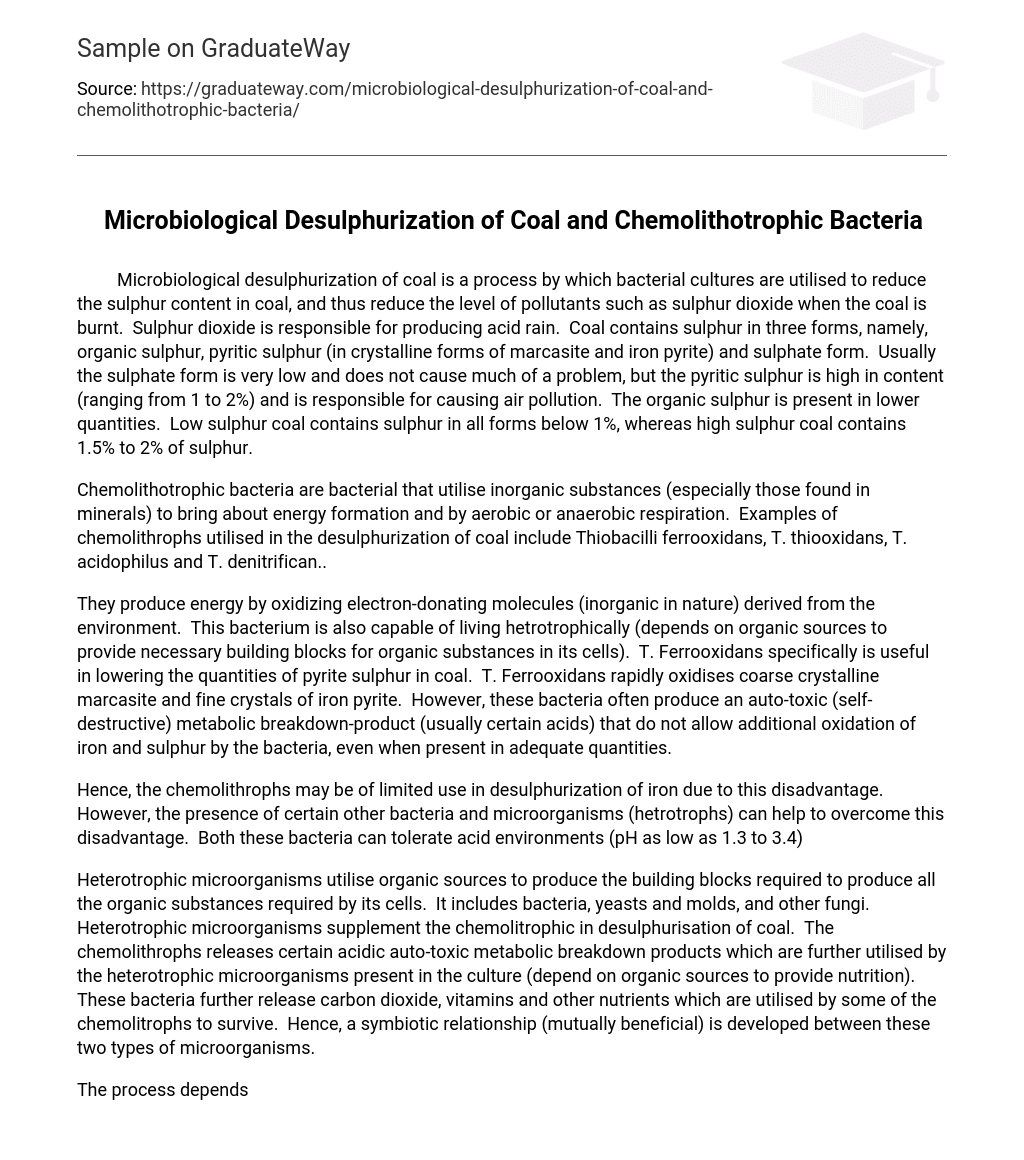Microbiological desulphurization of coal is a process by which bacterial cultures are utilised to reduce the sulphur content in coal, and thus reduce the level of pollutants such as sulphur dioxide when the coal is burnt. Sulphur dioxide is responsible for producing acid rain. Coal contains sulphur in three forms, namely, organic sulphur, pyritic sulphur (in crystalline forms of marcasite and iron pyrite) and sulphate form. Usually the sulphate form is very low and does not cause much of a problem, but the pyritic sulphur is high in content (ranging from 1 to 2%) and is responsible for causing air pollution. The organic sulphur is present in lower quantities. Low sulphur coal contains sulphur in all forms below 1%, whereas high sulphur coal contains 1.5% to 2% of sulphur.
Chemolithotrophic bacteria are bacterial that utilise inorganic substances (especially those found in minerals) to bring about energy formation and by aerobic or anaerobic respiration. Examples of chemolithrophs utilised in the desulphurization of coal include Thiobacilli ferrooxidans, T. thiooxidans, T. acidophilus and T. denitrifican..
They produce energy by oxidizing electron-donating molecules (inorganic in nature) derived from the environment. This bacterium is also capable of living hetrotrophically (depends on organic sources to provide necessary building blocks for organic substances in its cells). T. Ferrooxidans specifically is useful in lowering the quantities of pyrite sulphur in coal. T. Ferrooxidans rapidly oxidises coarse crystalline marcasite and fine crystals of iron pyrite. However, these bacteria often produce an auto-toxic (self-destructive) metabolic breakdown-product (usually certain acids) that do not allow additional oxidation of iron and sulphur by the bacteria, even when present in adequate quantities.
Hence, the chemolithrophs may be of limited use in desulphurization of iron due to this disadvantage. However, the presence of certain other bacteria and microorganisms (hetrotrophs) can help to overcome this disadvantage. Both these bacteria can tolerate acid environments (pH as low as 1.3 to 3.4)
Heterotrophic microorganisms utilise organic sources to produce the building blocks required to produce all the organic substances required by its cells. It includes bacteria, yeasts and molds, and other fungi. Heterotrophic microorganisms supplement the chemolitrophic in desulphurisation of coal. The chemolithrophs releases certain acidic auto-toxic metabolic breakdown products which are further utilised by the heterotrophic microorganisms present in the culture (depend on organic sources to provide nutrition). These bacteria further release carbon dioxide, vitamins and other nutrients which are utilised by some of the chemolitrophs to survive. Hence, a symbiotic relationship (mutually beneficial) is developed between these two types of microorganisms.
The process depends on the presence of several factors such as pH levels, enrichment culture, particle size of the coal, presence of slurry (coal with water) and initial pH adjustments. Chemolithrophs may fail to fully remove the sulphur to a reasonable level from the coal, when present independently in the cultures. In nature, hetrotrophs tend to survive in high-acidic environments from the auto-toxic metabolites produced by the chemolithotrophs or from the carbon content present in coal. The culture media used to propagate the bacteria contain certain coal-products along in a highly acidic media.
The chemolithrophs are capable of utilising iron and sulphur present in the coal instead of glucose, whereas the heterotrophs are capable of not capable of iron and sulphur, but prefer utilising glucose. Studies have shown that the chemolithotrophs and the hetrothophs were different genetically and antigenically from each other. It was also observed in nature that a relationship between chemolithrophic and heterotrophic organisms exist. However, only a few heterotrophs tend to survive in an acidic medium.
References:
Environmental Microbiology. Edited by P.D. Sharma. New Delhi, Narosa Publishing House, 2005.
Free Patents Online, Biological desulfurization of coal, United States Patent 4659670, 2006, retrieved 19 December 2006. http://www.freepatentsonline.com/4659670.html
Free Patents Online, Microbiological desulfurization of coal, United States Patent 4456688, 2006, retrieved 19 December 2006. http://www.freepatentsonline.com/4456688.html
Harrison, A.R., Jarvis, B.W. and Johnson, J.L. Heterotrophic Bacteria from Cultires of Autotrophic Thiobacillus ferrooxidans: Relationship as Studied by Means of Deoxyribonucleic Acid Homology. Journal of Biotechnology, 143(1): July. 1980: 448-454. http://jb.asm.org/cgi/reprint/143/1/448.pdf
Mannivannan, T., Sandhya, S., Pandey, R.A. Microbial desulfurization of coal by chaemoautotrophic thiobacillus ferrooxidans: An iron mine isolate. Journal of environmental science and health. Part A, Environmental science and engineering, 29(10): 1994: 2045-2061. http://cat.inist.fr/?aModele=afficheN&cpsidt=3362095
Rawlings, D.E. Characteristics and adaptability of iron- and sulfur-oxidizing microorganisms used for the recovery of metals from minerals and their concentrates. Microb Cell Fact, 4: May. 2005. http://www.pubmedcentral.nih.gov/articlerender.fcgi?artid=1142338





